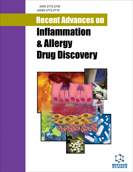Abstract
Breast cancer is a global issue, affecting greater than 1 million women per annum. Over the past two decades, there have been numerous clinical trials involving the use of various pharmacological substances as chemopreventive agents for breast cancer. Various pre-clinical as well as clinical studies have established numerous anti-inflammatory molecules, including nonsteroidal anti-inflammatory drugs (NSAIDs) and dietary phytochemicals as promising agents for chemoprevention of several cancers, including breast cancer. The overexpression of COX-2 has been detected in approximately 40% of human breast cancer cases and pre-invasive ductal carcinoma in-situ lesions, associated with aggressive elements of breast cancer such as large size of the tumour, ER/PR negative and HER-2 overexpression, among others. Anti-inflammatory molecules inhibit COX, thereby inhibiting the formation of prostaglandins and inhibiting nuclear factor-κBmediated signals (NF-kB). Another probable explanation entails inflammation-induced degranulation, with the production of angiogenesis-regulating factors, such as vascular endothelial growth factor, which can be possibly regulated by anti-inflammatory molecules. Apart from NSAIDS, many dietary phytochemicals have the ability to decrease, delay, or stop the progression and/or incidence of breast cancer by their antioxidant action, regulating inflammatory and proliferative cell signalling pathways as well as inducing apoptosis. The rapid progress in chemoprevention research has also established innovative strategies that can be implemented to prevent breast cancer. This article gives a comprehensive overview of the recent advancements in using antiinflammatory molecules in the chemoprevention of breast cancer along with their mechanism of action, supported by latest preclinical and clinical data. The merits of anti-inflammatory chemopreventive agents in the prevention of cardiotoxicity have been described. We have also highlighted the ongoing research and advancements in improving the efficacy of using antiinflammatory molecules as chemopreventive agents.
Keywords: NSAIDs, COX-2 inhibitor, dietary phytochemical, anti-oxidant, apoptosis, angiogenesis, prostaglandin, chemopreventive.
[http://dx.doi.org/10.1016/S0140-6736(16)31891-8] [PMID: 27865536]
[http://dx.doi.org/10.3322/caac.21583] [PMID: 31577379]
[http://dx.doi.org/10.3322/caac.21660] [PMID: 33538338]
[http://dx.doi.org/10.1007/s13304-017-0424-1] [PMID: 28260181]
[http://dx.doi.org/10.1016/j.breast.2015.07.035] [PMID: 26299406]
[http://dx.doi.org/10.1200/JCO.2013.54.8586] [PMID: 24868030]
[http://dx.doi.org/10.1186/s40659-017-0140-9] [PMID: 28969709]
[http://dx.doi.org/10.1093/carcin/21.3.525] [PMID: 10688873]
[http://dx.doi.org/10.1097/00008469-199612002-00001] [PMID: 9061288]
[http://dx.doi.org/10.2174/1568009043481632] [PMID: 14965265]
[http://dx.doi.org/10.1007/BF02975150] [PMID: 11794520]
[http://dx.doi.org/10.1148/rg.2020190084] [PMID: 32031911]
[http://dx.doi.org/10.1007/s10549-020-06092-5] [PMID: 33475878]
[http://dx.doi.org/10.3390/ijms21072605] [PMID: 32283655]
[http://dx.doi.org/10.3390/biom9050174] [PMID: 31064104]
[http://dx.doi.org/10.1007/s11356-020-08332-z] [PMID: 32193737]
[http://dx.doi.org/10.1016/j.canep.2012.02.007] [PMID: 22459198]
[http://dx.doi.org/10.1097/GRF.0000000000000239] [PMID: 27681694]
[http://dx.doi.org/10.1053/j.seminoncol.2017.11.002] [PMID: 29526255]
[http://dx.doi.org/10.1007/s13402-011-0010-3] [PMID: 21336636]
[http://dx.doi.org/10.1097/01.JAA.0000580524.95733.3d] [PMID: 31513033]
[http://dx.doi.org/10.1155/2013/139239] [PMID: 24455420]
[http://dx.doi.org/10.1016/j.coph.2016.11.004] [PMID: 27889687]
[http://dx.doi.org/10.21037/atm.2019.09.68] [PMID: 31807574]
[http://dx.doi.org/10.3389/fonc.2014.00246] [PMID: 25309872]
[http://dx.doi.org/10.3322/caac.21203] [PMID: 24114568]
[http://dx.doi.org/10.7150/ijbs.21635] [PMID: 29209143]
[PMID: 22199301]
[http://dx.doi.org/10.1038/onc.2011.655] [PMID: 22286762]
[http://dx.doi.org/10.1186/s13058-020-01335-1] [PMID: 32887656]
[http://dx.doi.org/10.1016/j.phymed.2018.11.001] [PMID: 31005718]
[http://dx.doi.org/10.1002/med.21514] [PMID: 29855050]
[http://dx.doi.org/10.1097/CEJ.0000000000000098] [PMID: 25380191]
[http://dx.doi.org/10.3390/ph3051550] [PMID: 27713317]
[http://dx.doi.org/10.1159/000452315] [PMID: 27920627]
[http://dx.doi.org/10.1016/j.jsbmb.2003.07.004] [PMID: 14623549]
[http://dx.doi.org/10.1016/S0027-5107(02)00329-9]
[PMID: 8813136]
[http://dx.doi.org/10.1016/S0049-3848(03)00379-7] [PMID: 14592543]
[http://dx.doi.org/10.1007/s10911-015-9333-4] [PMID: 26193871]
[http://dx.doi.org/10.1158/1940-6207.CAPR-10-0367] [PMID: 21212407]
[http://dx.doi.org/10.1016/S0960-0760(01)00131-5] [PMID: 11850206]
[http://dx.doi.org/10.1016/j.jsbmb.2005.04.013] [PMID: 15964185]
[http://dx.doi.org/10.1186/s13058-019-1135-y] [PMID: 30999962]
[http://dx.doi.org/10.1016/j.breast.2010.07.004] [PMID: 20724158]
[http://dx.doi.org/10.1038/sj.onc.1207295] [PMID: 14985703]
[http://dx.doi.org/10.1186/s13058-017-0840-7] [PMID: 28460643]
[http://dx.doi.org/10.1016/j.breast.2005.06.011] [PMID: 16169726]
[http://dx.doi.org/10.1517/13543784.13.10.1327] [PMID: 15461561]
[PMID: 10786667]
[http://dx.doi.org/10.2147/CMAR.S178567] [PMID: 30464589]
[http://dx.doi.org/10.1111/j.1349-7006.2000.tb01030.x] [PMID: 11011115]
[http://dx.doi.org/10.1016/j.canlet.2003.08.006] [PMID: 14643442]
[http://dx.doi.org/10.1158/1078-0432.CCR-07-0404] [PMID: 17875779]
[PMID: 10652588]
[http://dx.doi.org/10.1097/CEJ.0000000000000476] [PMID: 30339576]
[http://dx.doi.org/10.1186/s12885-015-1979-1] [PMID: 26673874]
[http://dx.doi.org/10.4103/0973-1296.108140] [PMID: 23661994]
[http://dx.doi.org/10.2174/187152012803833008] [PMID: 22583403]
[http://dx.doi.org/10.1016/j.foodchem.2019.125124] [PMID: 31288163]
[http://dx.doi.org/10.1016/j.jnutbio.2016.11.007] [PMID: 27951449]
[http://dx.doi.org/10.2174/1871520615666150304120643] [PMID: 25738871]
[http://dx.doi.org/10.2174/1389557520999201211194445] [PMID: 33319659]
[http://dx.doi.org/10.1016/j.phymed.2019.152883] [PMID: 30986716]
[http://dx.doi.org/10.1007/978-3-030-20301-6_16] [PMID: 31456191]
[http://dx.doi.org/10.3390/molecules24122277] [PMID: 31248102]
[http://dx.doi.org/10.1016/S0163-7258(99)00026-1] [PMID: 10576293]
[http://dx.doi.org/10.1017/S0029665114000585] [PMID: 24850051]
[http://dx.doi.org/10.5604/17322693.1102294]
[http://dx.doi.org/10.1111/j.1524-4741.2009.00709.x] [PMID: 19645775]
[http://dx.doi.org/10.1016/j.jnutbio.2010.11.001] [PMID: 21295962]
[http://dx.doi.org/10.1016/j.semcancer.2015.11.001]
[http://dx.doi.org/10.1007/s10549-008-0118-y] [PMID: 18636327]
[http://dx.doi.org/10.1186/s12199-018-0724-1] [PMID: 30092754]
[http://dx.doi.org/10.5604/17322693.1029528]
[http://dx.doi.org/10.1002/ptr.7044] [PMID: 33580629]
[http://dx.doi.org/10.1186/s13048-019-0530-4] [PMID: 31202269]
[http://dx.doi.org/10.3390/molecules24061076] [PMID: 30893792]
[http://dx.doi.org/10.1177/2211068216655524] [PMID: 27325106]
[http://dx.doi.org/10.3892/ijo.2018.4332] [PMID: 29620169]
[http://dx.doi.org/10.1111/bph.13625] [PMID: 27638711]
[PMID: 29687878]
[http://dx.doi.org/10.1007/s10549-019-05303-y] [PMID: 31165940]
[http://dx.doi.org/10.1016/j.tcm.2019.01.006] [PMID: 30745071]
[http://dx.doi.org/10.1158/1940-6207.CAPR-11-0166] [PMID: 21778329]
[http://dx.doi.org/10.1016/j.prostaglandins.2015.06.002] [PMID: 26100239]
[http://dx.doi.org/10.1177/107327480301000406] [PMID: 12915810]
[http://dx.doi.org/10.1007/978-0-387-46401-5_16] [PMID: 17569220]
[http://dx.doi.org/10.1016/j.lfs.2020.117463] [PMID: 32097663]
[http://dx.doi.org/10.3892/or.2017.5766] [PMID: 28677813]
[http://dx.doi.org/10.1016/j.fct.2020.111521] [PMID: 32640351]
[http://dx.doi.org/10.1111/jphp.13365] [PMID: 32930406]
[http://dx.doi.org/10.1080/01480545.2019.1650753] [PMID: 31412747]
[http://dx.doi.org/10.1111/j.1742-1241.2007.01668.x] [PMID: 18194278]
[http://dx.doi.org/10.1517/13543784.17.2.197] [PMID: 18230053]
[http://dx.doi.org/10.1002/ijc.23895] [PMID: 18798266]
[http://dx.doi.org/10.1007/3-540-26980-0_17] [PMID: 15648195]
[http://dx.doi.org/10.1080/10408398.2018.1551778] [PMID: 30632783]
[http://dx.doi.org/10.18632/oncotarget.24285] [PMID: 29568355]































